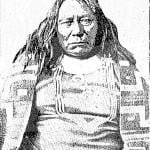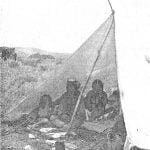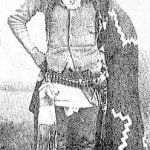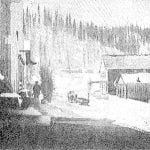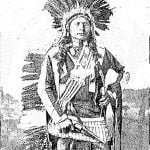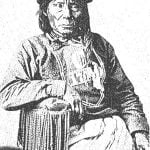Report of Special Agent George D. Meston on the Indians of Southern Ute, reservation, Southern Ute agency, Archuleta, La Plata, and Montezuma counties, Colorado, September and October 1890.
Names of Indian tribes or parts of tribes occupying said reservation: (a) Kapoti, Muachi, and Wiminuchi Ute.
The unallotted area of this reservation is 1,094,400 acres, or 1,710 square miles. It has been partially surveyed and subdivided. It was established, altered, or changed by treaties of October 7, 1883 (13 U. S. Stats., p. 673), and March 2, 1868 (15 U. S. Stats., p. 610) ; act of Congress approved April 29, 1874 (18 U. S. Stats., p. 36); executive orders, November 22, 1875, August 17, 1876, February 7, 1879, and August 4, 1882; and acts of Congress approved June 15, 1880 (21 U. S. Stats., p. 199), and July 28, 1882 (22 U. S. Stets., 178). Indian population 1800: 085.
Southern Ute Reservation

The Utes are as a rule extremely suspicious and inclined to be non-communicative. The reason given for this is the failure of the government to act on the agreement made in 1888, by which the Utes were to be removed to the new reservation in Utah, and the Indians think that they have been deceived, not only in this, but in several minor matters.
On account of the many recent interviews and conferences held with the Southern Utes by commissions and special agents regarding the proposed removal to Utah these Indians now begin to think themselves very important and assume arrogant and self-important airs, their every action betraying a race of spoiled children. Their duplicity of character is well established.
Until the question of removal to the new reservation is finally settled their progress in every direction will, to say the least, remain in a state of suspense.
The Southern Ute reservation is located in the extreme southwestern part of Colorado. It is about 120 miles long from east to west, bordering on New Mexico, and 15 miles in width from north to south, bordering on Utah, and contains 1,094,400 acres. Of this tract about one-fifth can be converted into arable land if proper irrigation facilities are provided. This is the roughest approximation, and nothing definite can be obtained except by a survey. The water supply is apparently sufficient to irrigate that amount of :land, but the remainder of the reservation is fit only for grazing.
Commencing at the west, the following rivers flew through the reservation, namely: Blanco, La Plata, Las Animas, Los Pinos, Mamas, and Piedra. Most of the land in these valleys is well adapted for irrigation, and some of it, especially on the Los Pinos or Pine River and the Florida (branch of the Animas), has already been placed under ditch, and, though done in rather a crude manner, the result has been very satisfactory.
There have been no lands allotted in severalty to the Indians on this reservation, but about 10 Indians are successfully engaged in farming, and have cultivated 600 acres of land, in fact, all there is cultivated on the river reservation. The farms are principally in the eastern and central part of the reservation. West of the Florida there is but little farming done.
A conservative estimate of the produce raised by these Indians in 1890 is as follows:
Oats 4,500
Wheat 4,000
Barley 500
Corn 100
Potatoes 600
Vegetables 700 (beans, turnips, onions, etc.)
A large quantity of fine melons and squashes was raised, and about 100 tons of hay and 25 tons of alfalfa were cut.
All the Utes, except the few who devote their time to agriculture, are engaged in stock raising, but not on a, large scale. Their goats and sheep have diminished somewhat in number recently, many having been slaughtered by the Indians for food. Their horses, many of which are broncos, are small and of inferior breed, only valued at from $10 to $30 each, The total value of the horses is a little over $100,000, and of the remainder of the stock about $15,000.
The following is as accurate a list of the stock owned by the Southern Utes, as it is possible to obtain: 6,000 horses, 500 cattle, 50 mules, 2,500 goats, and 1,500 sheep.
Tho stock range on this reservation is excellent, except in the eastern portion during the mouths of January and February, when the weather is very severe, the snow often falling to the depth of 3 feet on a level, occasioning serious losses among the cattle. The Utes make no provision for feeding their stock in whiter, and often find themselves obliged to cut down cottonwood trees for fodder or to remove temporarily to a better range in northern New Mexico and southeastern Utah.
The country occupied by the Weeminuches in the western part of the reservation contains a better year-round range, and consequently this band of the Utes have more and better stock. There are no mines on this reservation. There is considerable good timber found in the eastern half of the reservation, and the Utes cut for their own use over 100 cords last year. In the western half of Ute reservation there is no timber of any value to be found, excepting a little on the Ute mountains.
The air is pure and bracing, with day after day of continuous sunshine almost the entire year. Ignacio, where the agency is located, has an altitude of 6,450 feet above sea level, and commands a fine view of La Plata, The Needles, and San Juan ranges, with mountain streams and open fields, the foreground dotted with Indian tepees.
At this agency there are 8 frame and 2 log buildings, although the property list gives the total number as 15, which includes annexes and small outhouses. These buildings are in fair condition, and have a total value of about $4,000. The schoolhouse, which is not used at present, is the best building on the reservation, and valued at $900, it has no dormitory. The government has also erected 12 frame buildings, as individual property of the Indians at a cost of $1,800, which are also in fair condition. The small amount of furniture at the agency is worth about $200, Fanning implements, machinery, blacksmith and other tools are valued at $1,200. The list of government stock and the value are as follows: 99 stock cattle, $1,2003; 5 horses, $700; and 2 stallions, $600.
The Southern Utes are divided into 3 bands or tribes: the Capotes, Moaches, and Weeminuches, each of which has its chief. The Capotes and Moriches live together, principally on Los Pinot River, and are very friendly. The Weeminuches do not associate much with the other tribes, but live by themselves in the western part of the reservation, mainly on the Rio Maneas. While these eastern and western tribes are friendly to all appearances, they prefer to have nothing to do with each ether, and even on ration day the Weeminuches do not mix with the two other bands, but obtain their rations and return home as soon as possible. The Capotes and Moaches have more intercourse, and are more friendly even with the Jicarilla and Navajo Apache Indians than with the Weeminuches. Although this distant relation is ordinarily maintained, whenever a question arises which affects all the Utes these tribes are as one, and in general council are always united.
Ignacio, the head chief of all the Southern Utes, is 6 feet 3 inches tall and of magnificent physique. His influence and example are of the best. He discourages vices of every kind, and especially says that he “has no use for a Ute who will drink whisky.” He is one of time poorest of his race, as he distributes most of his money among the needy.
The total population of the Southern Utes, as enumerated by the Indian agent, is 985, the males numbering 481 and the females 501. Fifty-seven Utes have recently been removed to the Uinta agency, Utah. Of the total number men than one-half are Weeminuches. The other two tribes are nearly equal in numbers, the Moaches being slightly the larger of the two. Births daring the past year are given as 37, and the deaths 18, showing the slight increase of 19 in population. There is but one half-breed on the reservation, a little boy, half Negro and half Ute, son of the government interpreter.
The Southern Utes are great imitators. Their habits, language, manners, and dress are copied. In handicraft their only specialty is beadwork.
In appearance the Ute is a true Indian, though somewhat larger and stouter than the average. The skin shades from dark red to light brown; the teeth fine and white; hands and feet small; hair coarse, thick, and black, Which they wear long. There are no bald heads among them, even the patriarch of the tribe, whose age is estimated at nearly 100 years, being no exception. Some explain this by the fact that the Utes seldom wet their hair; but probably they retain their hair because of their outdoor life and their leaving the head uncovered more than the whites. Some of time Utes have no hair on any part of the body, the head and eyelashes excepted. It is all pulled out. But little hair grows on the face, and that is removed. It is also a general practice to pull out the hair from the eyebrows.
As a rule, the Utes oppose any innovation tending toward civilization, and time majority of them still retain their original mode of dress except on “ration days” or when visiting, when they may put on their colored toggery and decorations. About 25 Indians on this reservation wear citizens dress exclusively, and there are alma 100 who wear it in part. Vests possess a great fascination for them and are in great demand, but nearly every Ute carries his proverbial blanket wrapped about him. Most of the Indians carry as loaded revolver and wear a cartridge belt, but both seem to be more for ornament than for use, as their weapons are worn awkwardly, partly covered by their blankets, and consequently can not be drawn quickly.
The health of the Indians on this reservation is fairly good, considering the fact that they are not cleanly, and consequently are subject to disease. Syphilis is prevalent to some extent. Eczema is very common among them, and it is the result of malnutrition. Many have a habit of gorging themselves as soon as the government rations awe issued, devouring all their stores, and are then obliged to nearly starve during the remainder of the week. Another very common complaint is sore eyes, due somewhat, to the impure state of the blood, also in some degree to the lead in the paint with which they often decorate themselves, especially the eyelids. There is 1 blind and 1 crippled Ute on the reservation.
The medicine men are among the Utes a great hindrance to progress. They practice by “faith cure” and astrological methods. They will sometimes sit by a sick conch and howl all night, to drive away the devil, as they say. The medicine men, when ill themselves, are very willing to employ the skill of the agency physician. Confidence in the medicine man and his exorcisms is declining, and the Utes appreciate the value of the white man’s doctor, as his advice is often asked, though his prescriptions are frequently used with impatience. The physician is called to a confinement only in extreme cases; a squaw will generally attend to her regular duties both on the day before and the day after the birth of her papoose.
The sale of whisky on this reservation is prohibited, and its use is prevented as far as it is possible, but, spite of all care, whenever these Indians obtain money they will always manage to get whisky. Most of the trouble in this respect, as in all others, is caused by the Mexicans who live on the border lines and are continually selling whisky to the Utes. No matter how large a bribe may be offered, a man will never inform where he obtained his whisky. On the whole, however, comparatively little drunkenness is to be seen among these people.
Attempts are constantly made to prevent participation in games of chance, but the Southern Utes are inveterate gamblers, both men and women. The principal games played are Mexican monte and koon kan. It is not an uncommon sight to see from 5 to 20 Indians seated in a circle on the ground with is large blanket in the center, on which are the cards and stakes, playing the tile gamed koon kan. The game will often continue all day without interruption. There is apparently but little excitement, and no anger is ever displayed. The amount in the pool will vary from $1 to $20. While gambling should be prohibited, card playing for amusement should not be.
Tobacco is used among the Utes only to a slight extent. They smoke cigarettes of their own manufacture, which they prefer to cigars, because of their dislike to the taste of tobacco in the mouth, and also because a cigar is too strong. They seldom chew.
The Utes derive fully one-half of their support from the government in the form of rations; consisting principally of beef and flour, which is distributed to them once a week, on Wednesdays. The remaining portion of their sustenance is obtained partly by farming and stock raising; also a little by hunting and fishing.
The day immediately preceding ration day is marked by the slaughter of beef cattle, which is conducted in an open corral about half as mile from the agency buildings. The men perch upon the fence and the squaws leave their papoose cradles in a now against the fence and huddle together on the ground at the lower part of the corral, where they scramble for the entrails as they are thrown out to them by the butchers. The Indians preserve fresh meat by hanging it on poles to dry in the pure air. Ration day is the weekly holiday of the reservation, and from every direction the Indians come to agency headquarters in order to obtain their allotted supplies of beef and flour. The squaw is the one who procures the rations, as it is beneath the dignity of a man to assist in anything connected with the “mess”, except when absolutely necessary. This distribution is assisted by means of “ration tickets”.
With the exception of a few rude log huts and about a dozen small frame buildings created by the government the Utes live in tents or tepees, which are circular in form, with a slit in the top to permit the escape of smoke from the open wood. fire inside. This one fire serves every purpose, for cooking, heat, and light. When visiting these tepees it is impossible to stand up on account of the thick smoke, and the only hope to avoid suffocation is to follow the custom of the occupants and sit on the ground.
The Indians retain their primitive methods of eating, and 1 or 2 large kettles are placed on the ground, and the only utensils furnished are a board and a knife; but when visiting a white man the Indian betrays no awkwardness in using a knife and fork or in general table manners, and the only noticeable characteristic under these circumstances is the occasional loud smacking of the lips. If any dish especially pleases the taste.
The average number of children to a family of Utes is 3.
Nearly every Indian has 1 dog and some possess as many as 12. They are seldom fed by the Indians but as scavengers they are very valuable, as they keep the surroundings of the tepees free from debris, which would otherwise be a source of contagion.
If a Southern Ute sees a squaw who pleases his fancy, she is asked to be his “esposa”, and if she grants that request the next regular procedure is to see the parents. There is always a consideration paid, such as a horse or several blankets, except in the case of an orphan girl, who has no value. Even the guardians in such a case do not receive any compensation. In case of rivals, if the second suitor secures the prize, the unfortunate first suitor may take the established revenge and kill his rival’s best horse. No marriage ceremony seems to take place among these Indians, although there is an established rule requiring the couple to be seen in company for 2 consecutive nights and one day before being recognized us man and. wife. The following custom is practiced: if a man marries a widow and she has a daughter of marriageable age, it is usually the rite for the man to live with both, producing a family tree of many branches. The facts as to polygamy are difficult to obtain. Only 1 Ute confesses to having 2 wives, but there are reports of 2 others who each possess 3 squaws. Virtue is not very common among these Indians.
As a rule, the Utes make use of their own language only, but most of them can speak a little Spanish, and all understand it much better than English. Perhaps 30 can speak enough broken English to be understood, but there are not more than 10 who can read and write English. The Weeminuches, in the western part of the reservation, are surrounded by more Anglo-Americans and fewer Spanish-Americans, and as a consequence can understand English better than either the Capotes or Moaches.
At present there is no attempt being made toward education, The Indians refuse to send their children to any school off the reservation, principally on account of the unsettled question regarding their removal to Utah. Of the 3 bands, probably the Moaches are the best educated. There are perhaps 20 persons who desire an education and would willingly attend school, although the majority of the Utes want nothing to do with either education or religion.
No missionary work has been attempted among the Southern Utes. They seem to have no creed or religious faith further than a belief in a great spirit and an evil spirit. Sunday is observed to some extent, that is, no work is done, but the day is devoted principally to visiting and running horses.
There is a certain honor even among the Utes, although they are given to stealing and lying, but not more than many of their white brethern of the same class, and probably there is much more horse stealing done hereby the whites than by the Indians.
These Indians clearly understand the value of money, and will part with nothing, no matter how trivial, without a cash consideration. They prefer silver to paper currency, as they have, often been deceived by receiving counterfeit bills, in making purchases they pay for each article separately, and if credit is given them at the traders store they keep their accounts in their peculiar manner, usually by cutting a notch in a stick for each dollar due, and at a settlement it is found that their accounts generally agree to a cent with that of the trader. They all possess splendid memories for feces and incidents.
It is known that 18 members of the tribe have died during the past year, but no discovery has been made of their burial places.
The property of the deceased, including his tepee, blankets, guns, favorite stock, in fact all his personal belongings is burned. Out of respect to the memory of the deceased all the relatives cut their hair, the length varying according to the nearness of the relationship. The closer the connection the shorter the hair is cut.
It would be very difficult to find an Indian who is not extremely superstitious and a believer in omens and prognostications, but they simply follow the customs of their forefathers, It is especially difficult to learn the exact meaning, if there is any, of their many peculiar practices accompanying a dance. This is particularly true of the Southern Utes.
The bear dance is the principal Southern Ute dance. Many minor ones, notably the squaw and tea dances, are also performed at various times of the year, a large number of Indians taking part, especially during the summer, when there are often from 50 to 300 in the circle. The bear dance (boyle del oso), which is enjoyed by both men and squaws, and especially by all the young people, occurs but once a year, in the spring time, and often continues for 9 consecutive days and nights. It appears to be a sort of jubilee, celebration in recognition of the general awakening of nature and the appearance of a bear from his hiding place, which gives filename to the festivity. The dance occurs just across the river from the agency buildings, an open corral, at one side of which are the musicians, their instruments being holes in the ground covered with light boards, or sometimes a large wooden box. The players each hold 2 sticks in their hands, 1 of which is notched and the end placed upon the box. The sticks are then rubbed together and the musical sound produced in excellent time. In beginning the dance the squaws always choose their partners by forming in a line with joined hands, and thus approaching the men, who are sitting on the ground, make their selection from them. The squaws and men do not dance together, but two lines are formed, the men on one side and the squaws on the other, and as one line approaches the other retreats, both keeping time to the music, but never singing. The musicians furnish all the music, vocal as well as instrumental as they maintain it continual howling in connection with their stick playing. A big feast, attended by general dissipation, always follows the dance.
One of their most popular dances, namely, the dog dance (boyle del perro), was introduced among them about 4 or 5 year’s ago by some Uncompahgre Utes, together with a few Sioux and Cheyennes, who paid a visit to the Southern Utes, It is now a recognized dance among these Indians, and is performed once or twice a month, although not participated in by all. Some are strongly prejudiced against this dance, as they can net overcome their dislike for dog meat. The number of dancers varies from 30 to 50, all men. There is nothing extremely barbarous in this dance, as in the cases of the scalp and sun dances. Its special peculiarity is the eating of dogs. It is however, full of various ceremonies, the true meanings of which are not ascertainable. The first step in the proceedings is a wash in the river, and on coining out of the water they leave their garments where they were removed, wearing only the “gee-string”. They then put on various bracelets, bells, necklaces, and head feathers, and paint their faces and bodies in all imaginable designs and figures and in various colors. One large man had an enormous buffalo head painted in the middle of his back. While the dancers are bathing and adorning themselves the dog, which has been carefully selected beforehand, is killed. The principal qualifications demanded in the dog is that his ears must not droop, but stand up as straight as possible, After being killed the sacrifice is thrown at once upon the fire by the two cooks, singed, and the entrails removed, then put into a kettle and boiled. Meantime the bathers march to the dance ground two by two, the leaders being only three in number, all keeping time to the music. An enormous drum about 6 feet in diameter is beaten by 12 musicians, who are also vocalists, and apparently very anxious to display their musical talents. The dancers first arrange themselves in a circle on the ground, and at intervals they all rise and dance for 2 minutes, each waving a bunch of feathers in the air, then sit down for a minute. These alternations continue for 2 hours. With an exception of an occasional yelp, not a sound is uttered by the dancers, but the drum orchestra of 12, located outside of the circle, maintains a continual display. At the expiration of the 2 hours the cooks appear, bringing in the dog, at the sound of a “dead march”. It is carried in a kettle covered with brush, suspended from a stick, and placed at one side of the ring, upon which the dancers rise and dance around the dog, occasionally making a stab at it, but purposely missing it. A small fire is then made and all the dancers remove their ornaments and feathers and place them on the ground in a semicircle. These are then waved, one by one, over the smoke by one of the Indians, and again the general dancing goes on, during which each article is picked up by the respective owner and replaced on his person. They then sit down again in a circle and the dog is brought into the ring by the cooks. Immediately one of the dancers springs up with a wooden two-pronged spear in his hand, with which he makes an imaginary thrust at the dog, missing his aim, and then at the master of ceremonies, who titters a yelp and avoids the stroke by dodging. This performance is repeated three times, when the dimmer finally sticks the dog, withdraws his spear, and drops it at one side of the kettle. The master of ceremonies then rises, proceeds solemnly to the dog kettle, takes a small piece of the meat in his hand, and, with extended arm, points to the east, north, west, and south, the zenith, and the nadir; then returns to his place. Thereupon the two cooks and the master of ceremonies remove the dog from the kettle, and with their hands tear it into pieces, laying an equal portion in front of each dancer on a chip of wood, Various edibles; such as melons, canned goods, and coffee, are also distributed, but no one eats until the division is completed, when one of the Indians rises with a stick in his hand and approaches one of his fellow dancers, places the stick in the food which is in front of him, and then in the mouth of the dancer, who is seated on the ground. The latter utters an unintelligible sound as the Indian passes on. This is repeated with each one until the circle is made. Then upon a signal from the master of ceremonies the dance is over and the eating begins.


